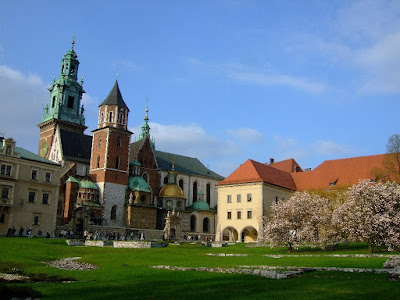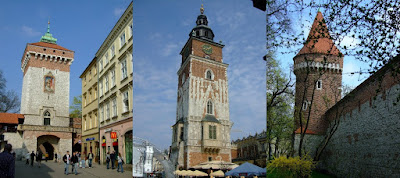
What can one write about Auschwitz that has not already been said? It seemed incongruous to be visiting this scene of unspeakable horror and death on a beautiful spring day with the fresh new spring growth, the symbol of life and a future, budding all around us.
It is a full day excursion so

we were up and on our way to the bus station early to catch the express bus from Krakow, only to find a long queue at the only open ticket office and then find all the seats sold. The next bus was 50 minutes later so we spent the time nattering to two other Kiwi couples before setting off for the 90-minute journey. We were still in time for the 11 a.m. English tour with Berta, a wonderful guide.
Auschwitz-I was a men only camp using an existing army barracks so was relatively palatial compared to the rigours of Auschwitz-II or Birkenau.

How anyone survived winter in that bleak place in those camp buildings is a mystery. Prefabricated stables not holding the 52 horses they were designed for but rather 400+ prisoners, three levels deep, in incomprehensible conditions is just too hard for us to imagine or identify with.
The dehumanising processes, controls and conditions, graphically recounted by the guide and the display boards,

are simply too much to absorb and while the information is processed by the brain the horror cannot really be understood. There were no trees breaking the view then, there was no grass underfoot, there was only death for the majority and a 10km walk each way to the work sites for the 'healthy' ones.
The strength of the human instinct to survive is evidenced in so many ways: whether in the pile of bodies under the air vents as they clambered on the bodies of others for the last gasps of fresh air in the gas chambers; or in the motivation of the capos who would treat their fellows more harshly than the SS in the hope of

buying a few more days; or those who felt themselves fortunate to have the task of cleaning the latrines and so on. With the certain knowledge of the finality of the solution waiting for them in the gas chambers at the far side of the camp there were those who hoped with a hope so far beyond hope that the new day might bring life instead of death and so endured for one more day and one more day.

Why they simply did not give up is truly something that we, in our cushy western world, cannot begin to understand.
The mentality of the Germans captors is also hard to comprehend. Apart from the obvious question as to how any rational person could be part of such barbarity, the fact that they would photograph and record the name, date of birth, date of arrival at the camp and date of death of a prisoner that was to be killed that same day is mind-boggling. Later the numbers murdered precluded any such record keeping

but did not stop them collecting the toothbrushes, hair brushes, shaving brushes and so on.
But soon it was time to return and the bus timetable was not running the full service so it was a toss-up which bus to try for. We got back to Auschwitz-I in time for the 16:20 but it was full so we decided not to stand for 90 minutes. We had another look around the camp and then set off for the 17:30 bus. Before long there was at least two bus loads of people standing around and certainly not in a orderly British queue. I had stationed myself at the kerbside where I estimated the bus door would be and we stood and waited. Sure enough the door was directly in front of me when the

bus arrived and we smuggly took our seats while the melee outside the door attempted to board the bus.
Eventually we left, but less than five minutes later the bus died and we had to wait for a replacement. Now those standing in the aisle had a distinct advantage over those of us in the seats as we scrambled from one bus to the next. Fortunately we secured seats again, just.
Dinner that evening continued the Jewish theme as we ate in the old Jewish quarter at a

restaurant called “Once Upon A Time in Kazimierz”. Walls have been removed to amalgamate four old Jewish establishments: The General Store; a Tailors workroom and shop; a carpentry workshop and a Grocery store. Each section is furnished and decorated to reflect its original use giving the restaurant a wonderful atmosphere; complimented by the delicious food.
 For many years the English Midlands have been the heart of British motor manufacturing. In the early 1900s Austin opened their plant at Longbridge and later, when the MG Abingdon plant closed the MGs were made at Longbridge, along with Morris and the rest of the BMC fold.
For many years the English Midlands have been the heart of British motor manufacturing. In the early 1900s Austin opened their plant at Longbridge and later, when the MG Abingdon plant closed the MGs were made at Longbridge, along with Morris and the rest of the BMC fold. wound down, sold off etc and many thousands of workers lost their jobs.
wound down, sold off etc and many thousands of workers lost their jobs. sole representative of the latest 2008 model. Some were polished way beyond anything that they may looked like when leaving the factory, others had significant bodywork alterations, one had £3000 of additional lighting installed and some were simply family cars, grime and all.
sole representative of the latest 2008 model. Some were polished way beyond anything that they may looked like when leaving the factory, others had significant bodywork alterations, one had £3000 of additional lighting installed and some were simply family cars, grime and all.

 Next was a country walk from Shelfield Green and, for only the second time on these country walks, we got ourselves lost. We retraced our steps and drove to the pub at Wotton Wawen that we were supposed to walk past. Since most of the things to see on the walk were around Wotton Wawen we explored the area on foot and then enjoyed a pub meal before heading home.
Next was a country walk from Shelfield Green and, for only the second time on these country walks, we got ourselves lost. We retraced our steps and drove to the pub at Wotton Wawen that we were supposed to walk past. Since most of the things to see on the walk were around Wotton Wawen we explored the area on foot and then enjoyed a pub meal before heading home.




































